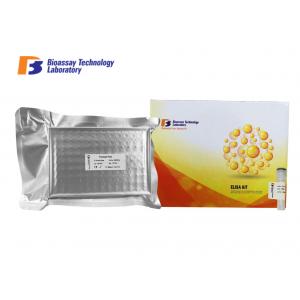Strip Plate Rat ELISA Kit For A Disintegrin / Metalloprotease 30 Presence Analyzing
Add to Cart

96 Wells Rat High Specificity Fibroblast Growth Factor-23 ELISA Kit For Research
Cat.No E0170Ra
Standard Curve Range: 5pg/ml - 1500pg/ml
Sensitivity: 2.56pg/ml
Size: 96 wells
Storage: Store the reagents at 2-8°C. For over 6-month storage refer to the expiration date keep it at -20°C. Avoid repeated thaw cycles. If individual reagents are opened it is recommended that the kit be used within 1 month.
*This product is for research use only, not for use in diagnosis procedures. It’s highly recommend to read this instruction entirely before use.
Precision
Intra-Assay Precision (Precision within an assay) Three samples of known concentration were tested on one plate to assess intra-assay precision.
Inter-Assay Precision (Precision between assays) Three samples of known concentration were tested in separate assays to assess inter-assay precision.
CV(%) = SD/mean x 100
Intra-Assay: CV<8%
Inter-Assay: CV<10%
Intended Use
This sandwich kit is for the accurate quantitative detection of Rat Fibroblast Growth Factor-23 (also known as FGF-23) in serum, plasma, cell culture supernates, cell lysates, tissue homogenates.
Precautions
- Prior to use, the kit and sample should be warmed naturally to room temperature 30 minutes.
- This instruction must be strictly followed in the experiment.
- Once the desired number of strips has been removed, immediately reseal the bag to protect the remain from deterioration. Cover all reagents when not in use.
- Make sure pipetting order and rate of addition from well-to-well when pipetting reagents.
- Pipette tips and plate sealer in hand should be clean and disposable to avoid cross-contamination.
- Avoid using the reagents from different batches together.
- Substrate solution B is sensitive to light, don’t expose substrate solution B to light for a long time.
- Stop solution contains acid. Please wear eye, hand and skin protection when using this material. Avoid contact of skin or mucous membranes with kit reagent.
- The kit should not be used beyond the expiration date.
Specimen Collection
Serum Allow serum to clot for 10-20 minutes at room temperature. Centrifuge at 2000-3000 RPM for 20 minutes.
Plasma Collect plasma using EDTA or heparin as an anticoagulant. Centrifuge samples for 15 minutes at 2000-3000 RPM at 2 - 8°C within 30 minutes of collection.
Urine Collect by sterile tube. Centrifuge at 2000-3000 RPM for approximately 20 minutes. When collecting pleuroperitoneal fluid and cerebrospinal fluid, please follow the procedures above-mentioned.
Cell Culture Supernatant Collect by sterile tubes when examining secrete components. Centrifuge at 2000-3000 RPM for approximately 20 minutes. Collect the supernatants carefully. When examining the components within the cell, use PBS (pH 7.2-7.4) to dilute cell suspension to the cell concentration of approximately 1 million/ml. Damage cells through repeated freeze-thaw cycles to let out the inside components. Centrifuge at 2000-3000 RPM for approximately 20 minutes.
Tissue Rinse tissues in PBS (pH 7.4) to remove excess blood thoroughly and weigh before homogenization. Mince tissues and homogenize them in PBS (pH7.4) with a glass homogenizer on ice. Thaw at 2-8°C or freeze at -20°C. Centrifuge at 2000-3000 RPM for approximately 20 minutes.
Note
- Sample concentrations should be predicted before being used in the assay. If the sample concentration is not within the range of the standard curve, users must contact us to determine the optimal sample for their particular experiments.
- Samples to be used within 5 days should be stored at 2-8°C. Samples should be aliquoted or must be stored at -20°C within 1 month or -80°C within 6 months. Avoid repeated freeze thaw cycles.
- Samples should be brought to room temperature before starting the assay.
- Centrifuge to collect sample before use.
- Samples containing NaN3 can’t be tested as it inhibits the activity of Horse Radish Peroxidase (HRP).
- Collect the supernatants carefully. When sediments occurred during storage, centrifugation should be performed again.
- Hemolysis can greatly impact the validity of test results. Take care to minimize hemolysis.
*Sample can't be diluted with this kit. Owing to the the material we use to prepare the kit, the sample matrix interference may falsely depress the specificity and accuracy of the assay.
Assay Procedure
1. Prepare all reagents, standard solutions and samples as instructed. Bring all reagents to room temperature before use. The assay is performed at room temperature.
2. Determine the number of strips required for the assay. Insert the strips in the frames for use. The unused strips should be stored at 2-8°C.
3. Add 50μl standard to standard well. Note: Don’t add antibody to standard well because the standard solution contains biotinylated antibody.
4. Add 40μl sample to sample wells and then add 10μl anti-FGF-23 antibody to sample wells, then add 50μl streptavidin-HRP to sample wells and standard wells (Not blank control well). Mix well. Cover the plate with a sealer. Incubate 60 minutes at 37°C.
5. Remove the sealer and wash the plate 5 times with wash buffer. Soak wells with at least 0.35 ml wash buffer for 30 seconds to 1 minute for each wash. For automated washing, aspirate all wells and wash 5 times with wash buffer, overfilling wells with wash buffer. Blot the plate onto paper towels or other absorbent material.
6. Add 50μl substrate solution A to each well and then add 50μl substrate solution B to each well. Incubate plate covered with a new sealer for 10 minutes at 37°C in the dark.
7. Add 50μl Stop Solution to each well, the blue color will change into yellow immediately.
8. Determine the optical density (OD value) of each well immediately using a microplate reader set to 450 nm within 10 minuets after adding the stop solution.
Referances
"Renal expression of FGF23 in progressive renal disease of diabetes and the effect of ACE inhibitor."
Zanchi C., Locatelli M., Benigni A., Corna D., Tomasoni S., Rottoli D., Gaspari F., Remuzzi G., Zoja C.
PLoS ONE 8:e70775-e70775(2013)


